Saving butterflies, moths and our environment
Celebrating our 40th Anniversary!
1982 - 2022
Painted Lady at St Catherine's Hill. Singleton Painted Lady seen on the old water works at St Catherine's Hill today. Quite worn colours. [Posted by Mike Allen]
A new Campaign. Head Office has today announced a new campaign 'Plant Pots for Pollinators' which is sponsored by B&Q and will run until the end of June.
Gardeners are being asked to help the UK’s beleaguered butterflies, bees and moths by making their county the most pollinator-friendly in the UK.
Butterfly Conservation is trying to discover which UK county is home to the most butterfly-friendly gardens after it was revealed that butterflies are declining faster in urban areas than in the countryside.
More information is available at http://butterfly-conservation.org/48-16490/find-the-uks-most-pollinator-friendly-county.html [Posted by Bob Whitmarsh]
Bentley Wood Field Trip. Today was the better of the two field trips weather wise however for counts of butterflies it was certainly the poor relation to Martin Down yesterday. The Eastern Clearing is a shadow of its former self, and sooner the cattle grazing regime starts the better. The book reads in the car-park with just (1)Duke of Burgundy being seen which just emphasises how poor they have been this year. Today we managed just (10) Pearl-Bordered Fritillaries most being very faded and worn, and the Small Pearl-Bordered Fritillary there was (11) being seen which was a good count, in my book considering how far they have come to the edge of extinction in the county. We were glad to see the Argent and Sable Moth at least (4) being noted but they are a devil to photograph. Other than that there was Red Admiral, Common Blue, Speckled Wood, Speckled Yellow, Treble Bar, and Cinnabar Moth to be seen. [Posted by Ashley Whitlock]
Martin Down Field Trip. Again the weather was against us in the morning with thick black clouds, and hardly a butterfly in sight when we walked around Kitts Grave in the first couple of hours. But by lunchtime it had become warmer, and the sun was starting to peep through the thick blanket of clouds. In the afternoon we saw so many Adonis Blues, I lost count really,
I've never had the privilege of seeing so many, after visiting this site for over twenty years despite the weather this was definitely the best! Good counts of Marsh Fritillary and Small Blue as well. We had (17) species of Butterfly and several moth species the highlight being the Cream Spot Tiger Moth. Species recorded were as follows: Grizzled Skipper (2) Common Blue (20+) Small Heath (17) Speckled Wood (4) Adonis Blue (67++) Dingy Skipper (5) Marsh Fritillary (25+) Brown Argus (3) Small Blue 28+) Brimstone (7) Painted Lady (1) Holly Blue (1) Green Hairstreak (1) Red Admiral (1) Green-veined White (2) Small White (2) Small Copper (1). Id like to thank all those who came all 22 of you a great turn-out and despite the weather it turned out alright in the end. [Posted by Ashley Whitlock]
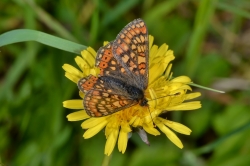 | 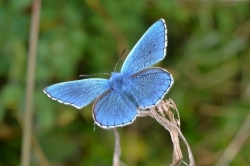 |  |
| Greasy Fritillary Photo © Ashley Whitlock | Male Adonis Blue Photo © Ashley Whitlock | Martin Down looking North-East Photo © Ashley Whitlock |
Northington Down. While taking an evening stroll around the back fields at the end of a glorious day we found two Painted Ladies, rather dusty, basking in warm sunshine on the track. [Posted by Robert Bryant]
Painted Lady. After a really quiet day when I could find hardly any butterflies locally - It's hot it's dry and there is plenty of shelter, where are they? - I was pleased to see a Painted Lady in the garden during the afternoon. A little worn, so probably just arrived. [Posted by Chris Rose]
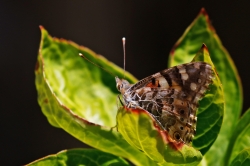 |  |
| Painted Lady Photo © Chris Rose | Painted Lady Photo © Chris Rose |
Abbotstone Down nature reserve. Off for a ramble on a scorching day, I found a Green Hairstreak on one of the ant-hill tussocks and stumbled across a mating pair of Common Blues swaying in long grass. [Posted by Robert Bryant]
Stockbridge Down. A sweltering day too hot to be walking around too long. I went to Stockbridge Down to see how the woodland Dukes were getting on. Most have now gone but there are a few females hanging on, and I managed to photograph a female laying eggs.One Pearl-bordered Fritillary was seen, the rest of of the species were made up of very numerous Brimstones, and Common Blues, with a sprinkling of Small Heath, Green-veined White, Peacock, and Brown Argus. [Posted by Ashley Whitlock]
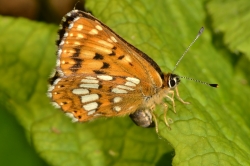 |  | 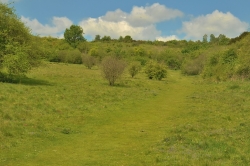 |
| Female Duke of Burgundy laying eggs on the edge of a Primrose leaf Photo © Ashley Whitlock | Pearl-Bordered Fritillary Photo © Ashley Whitlock | Stockbridge Down Photo © Ashley Whitlock |
Fresh Painted Lady in Garden, Petersfield. After the slight disappointment of Rakes Bottom today, a welcome sight on my return to the garden in Petersfield - a fresh and very cooperative Painted Lady enjoying the Sweet Rocket. [Posted by Phil Hooper]
 | 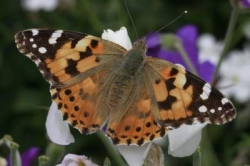 |
| Photo © Phil Hooper | Photo © Phil Hooper |
Mixed Bag at Rakes Bottom. After an initially encouraging but hastily truncated visit on Monday - a swarm of bees stopped play! - I returned lunchtime today under cloudy but hot and sultry skies. Some numbers were reduced since (Monday in brackets),others better and even the Cuckoos found it too soporific for much of an effort. I managed to spot 5 Duke of Burgundys (6), 8 Common Blues (30+), 30+ Small Heath (12),4 Brimstones (9),4 Speckled Wood (6), 1 Red Admiral (1), 1 Painted Lady (0), 1 Brown Argus (3), 2 Grizzled Skippers (11), 7 Dingy Skippers (17). There were no Green Hairstreaks today (2) nor, fortunately, was there any sign of the bees.... [Posted by Phil Hooper]
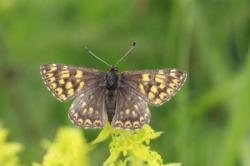 | 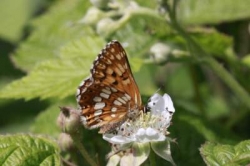 |
| Photo © Phil Hooper | Photo © Phil Hooper |
Old Winchester Hill. Today I visited Old Winchester Hill (SU6420), where the weather was hazy sunshine with a strong Southerly wind, the temperature reaching 17.5 degrees. Due to the strong breeze on the higher ground there were disappointing numbers seen, including no Common Blues or Skippers noted at all. I walked the main path to the Hill Fort and around the outer path, then descended the steps and returning to the main track once more (rather than continuing to the woods and up via the steep car park slope).
Totals: Brimstone 2M 2F, Green-veined White 1, Small White 4, Small Heath 3, Speckled Wood 1,Peacock 1, Red Admiral 1. [Posted by Roy Symonds]
Chalton Down, Old Idsworth. After visiting Old Winchester Hill, on the way home I call at Chalton Down (SU736156). Here there was also a breezy wind with a poor number of sightings, although the temperature was 18 degrees. Once more again no Skippers flying.
Toatls: Brimstone 3M 2F, Orange-tip 2M, Small White 3, Common Blue 5M, Small Heath 4. [Posted by Roy Symonds]
Mating Adonis At Old Winchester Hill. This afternoon, I made a short exploration of the car park slope at Old Winchester Hill. Significant cutting back of the scrub has been undertaken on the lower part of the slope, which should benefit several species. A fresh male Adonis Blue was fluttering around scat on the path at the bottom of the slope. A further 4 Adonis Blues were seen amongst the scrub below the path including a mating pair, hopefully securing their reappearance in August. I was also pleased to reconnect with both Grizzled Skipper (2) and Dingy Skipper (1) in the area beyond the main slope - species which I have not seen here for a while. Other species seen were Common Blue (5) and Small Heath (2). [Posted by Alan Thornbury]
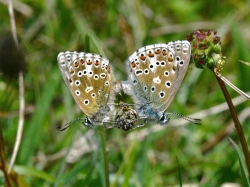 | 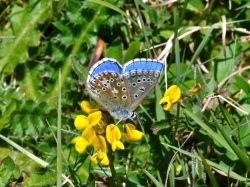 |
| Adonis Blue (Mating Pair) Photo © Alan Thornbury | Adonis Blue (Male) Photo © Alan Thornbury |
Mating Holly Blues. I was lucky enough this afternoon in blazing sunshine to witness two Holly Blues mating on my Cape Daisies. I dont know how long they had been mating but they stayed paired for about twenty minutes before getting buzzed by other Holly Blues and then they were off... [Posted by Ashley Whitlock]
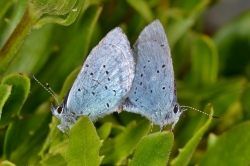 |  | 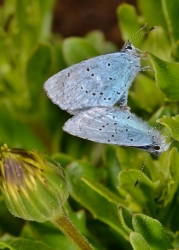 |
| Mating Holly Blues Photo © Ashley Whitlock | The head of the male Photo © Ashley Whitlock | Holly Blues mating on Cape Daisies Photo © Ashley Whitlock |
Beacon Hill NNR. This is the probably the last week of the Duke on Downland some of which are looking a little ragged. I decided to go to a lesser known site at Exton Beacon Hill NNR today. The site is probably the hardest to locate the species as it's very large and the site, where the Duke is found faces North-North East and is still very scrubby in places despite on the slopes towards the car-park area, are being left like billiard tables by the cattle grazing regime, which is hoped will do the Silver-spotted Skipper no end of good, and encourage them to breed more on the downland. Today the counts were still very small: Large White (1) Small White (1) Orange-tip (3) Red Admiral (3) Peacock (1) Brimstone (25) Common Blue (16) Mother Shipton Moth (2) Duke of Burgundy (4) Speckled Wood (1) Green Hairstreak (3) Small Heath (6) Dingy Skipper (3) and last but not least Brown Argus (2) [Posted by Ashley Whitlock]
Chalton Down, Old Idsworth. In hazy sunshine, I visited Chalton Down (SU736156) where the temperature was 16.5 degrees. Several Brimstones were flying but other species were all in very small numbers, with just 2 Dingy Skippers flying and no Grizzled Skippers seen at all. Despite the numbers a total of 9 species were recorded.
Totals: Brimstone 5M 3F, Orange-tip 1M, Small White 2, Common Blue 3M, Small Heath 1, Speckled Wood 1, Peacock 1, Red Admiral 1, Dingy Skipper 2. [Posted by Roy Symonds]
Oxenbourne Down. After my visit to Chalton Down, I visited Oxenbourne Down (SU7118). Here numbers were a little higher and while I was about to take a photo of a Small Heath, my first Green Hairstreak this year landed next to it.
Totals: Brimstone 4M 2F, Orange-tip 1M, Green-veined White 1, Common Blue 5M 1F, Green Hairstreak 1, Small Heath 4, Dingy Skipper 6. [Posted by Roy Symonds]
Porton Down Survey. Porton Down Survey [Posted by Ashley Whitlock]
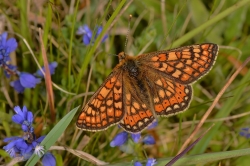 | 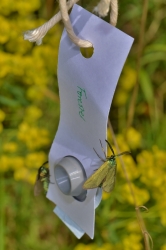 | 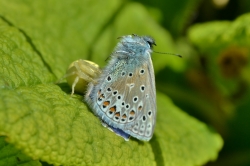 |
| Marsh Fritillary with one full antennae Photo © Ashley Whitlock | Forester Moths on a Pheromone tag Photo © Ashley Whitlock | Common Blue and a Crab Spider Photo © Ashley Whitlock |
Porton Down survey. More Photos of the Porton Down survey [Posted by Ashley Whitlock]
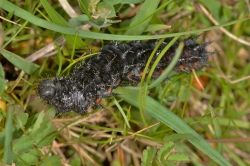 | 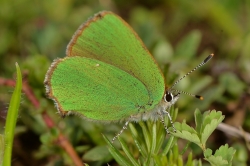 | 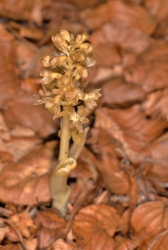 |
| Dark-Green Fritillary Caterpillar Photo © Ashley Whitlock | Female Green Hairstreak Photo © Ashley Whitlock | Birds Nest Orchid Photo © Ashley Whitlock |
Porton Down Field Survey. Today was probably a highlight of my Butterfly year, so far which after some early morning cloud turned out to be almost perfect weather. Up to twelve recorders were briefed and we all looked in at the large woods just inside the Hampshire and Wiltshire Border known as the Isle of Wight Woods. As we parked up we saw many Marsh Fritillaries which were all pretty fresh and here their main foodplant is Small Scabious which was a surprise to me. As we walked through the wonderful Beech woodland we looked in on many large tracts of scrubby downland, this typical habitat was the home of mega-amounts of Primrose consequently we saw the Woodland Duke of Burgundy on the wing. These were in good condition as well. The only disappointment was the lack of Pearl-Bordered Fritillary, it was here on the Friday but today it was very scarce with only two individuals being reported. We moved through the woodlands looking in on various sites which were very old with large ant-hills, and these in turn were covered in Rock-Rose, hense the very good numbers of Brown Argus, we even had Green Hairstreak laying on these plants.We also saw very rare plants like Birds Nest Orchids, and Meadow Clary, which is almost unique to the area. On the Downland we saw several Dark-green Fritillary caterpillars moving very swiftly through the tall grasses. Dan also set a Forester Moth trap hung on a bush to attract the same insect wafting out Forester Moth pheromones, which worked a treat. I could go on but the results were as follows: Cinnabar Moth (10) Six-Spot Burnet Moth (2) Dingy Skipper (18) Duke of Burgundy (43) Brimstone (7) Small Heath (8) Garden Tiger Moth (2) Mother Shipton Moth (9) Small Copper (4) Forester Moth (15) Common Blue (25) I also found one struggling with a crab spider which soon became paralyzed by the poison injected into it. Grizzled Skipper (5) Brown Argus (25) Green Hairstreak (6) Green-veined White (1) Large White (1) Peacock (1) Red Admiral (1) Marsh Fritillary (21) Comma (1)Pearl-bordered Fritillary (2) Speckled Wood (5) Silver-'Y' Moth, there were loads of Micro moths and other moths going unregistered. All in all a pretty good day in a landscape which hasn't changed for decades, and long may it continue. [Posted by Ashley Whitlock]
 | 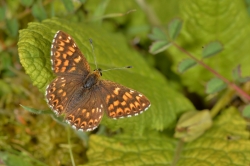 | 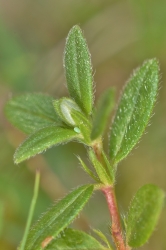 |
| The Landscape Photo © Ashley Whitlock | Duke of Burgundy on Primrose Photo © Ashley Whitlock | Green Hairstreak egg on Rock-Rose Photo © Ashley Whitlock |
Martin Down. Today, Dave and I visited Martin Down to see the Marsh Fritillaries. We arrived around 10.30am and spent an enjoyable 3 and half hours wandering up and down Bokerley ditch and the rifle range.
A good range of butterflies were seen and many photographs were taken. The Marsh Frits. were not just confined to the ditch and were seen in several locations along our route. Other highlights were a pair of mating Common Blues where, unusually, the male was much larger than the female. When they parted company the female opened her wings and turned out to be a beautiful very blue form. We also found a few Small Blues in the ditch and several Dingy Skippers. 3 were seen at once, chasing around each other. Dotted across the area were 5 Grizzled Skippers and a single Green Hairstreak. Brown Argus and a couple of Peacocks along with good numbers of Brimstone and Small Heaths were also present.
We always seem to find a large a hairy caterpillar whenever we come here and today was no exemption. This time it was a lovely Drinker moth caterpillar.
On the way back to the carpark Dave spotted a single Speckled Wood, and a couple more Marsh Fritillaries and Dingy Skippers were seen.
All in all we saw (in aprox. Numbers) 15+ Marsh Fritillary (All we got close to were males) 20+ Small Heath, 20+ Brimstone, 5 Grizzled Skippers, 15+ Dingy Skippers, 2 Peacocks, 1 Green Hairstreak, 6-8 Small Blues all male except 1, 2 Orange-tips, males, 7 Common Blues 4 males, 3 females, 3 Brown Argus all males and 1 Speckled Wood. [Posted by Tracy Piper]
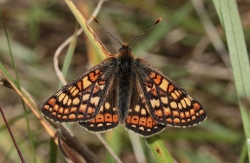 | 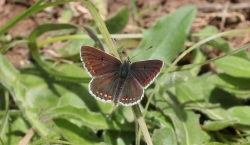 | 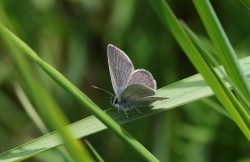 |
| Marsh Fritillary male Photo © Tracy Piper | Brown Argus male Photo © Tracy Piper | Small Blue male Photo © Tracy Piper |
Martin Down. some more photos... [Posted by Tracy Piper]
 |  | 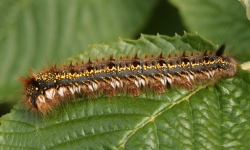 |
| Common Blues Photo © Tracy Piper | Lovely blue female after mating Photo © Tracy Piper | Drinker moth caterpillar Photo © Tracy Piper |
Eastern Clearing Bentley Wood. After spending the morning on the coast we decided to chance our luck and visit Bentley Wood in the hope of finding some late Pearl-bordered Fritillaries. As we pulled into the car park it started to rain, but not to be put off we walked around the clearing much in hope. A short burst of sunshine did the trick and produced 3 Pearl-borderd Fritillaries all in a mixed state of wear. These and a couple of Speckled Yellows were all we found during the hour spent searching [Posted by Chris Rose]
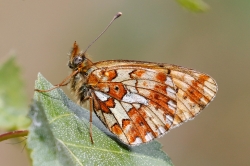 | 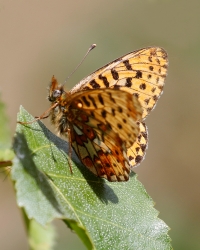 | 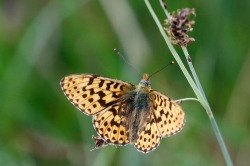 |
| Pearl-bordered Fritillary Photo © Chris Rose | Pearl-bordered Fritillary Photo © Chris Rose | Pearl-bordered Fritillary Photo © Chris Rose |
Oxenbourne Down. There was an awful lot of Black clouds on the Horizon when I visited this site today and they had had a lot of rain. The species count was poor and the Duke of Burgundy was almost absent, and in fact the species on the Downlands is pretty much over, especially at sites where there are only a handful normally seen. Species seen were as follows: Dingy Skipper (4) Green Hairstreak (1) having a poor year wherever I visit. Speckled Wood (1) Speckled Yellow (5) Duke of Burgundy (1) and Common Blue (1 [Posted by Ashley Whitlock]
 |  |  |
| Speckled Wood Photo © Ashley Whitlock | Green Hairstreak Photo © Ashley Whitlock | Dingy Skipper Photo © Ashley Whitlock |
Busman's Holiday. Having recently become reacquainted with the Pearl-bordered Fritillaries of the New Forest, through my work for Butterfly Conservation, I returned to look in more detail at some of the great work being conducted here by BC and the Forestry Commission. This busman's holiday was very much a 'trip down memory lane', as the previous visit had rekindled happy memories in search of New Forest butterflies with my father, 45 years ago. I then moved on to Bentley Wood Eastern Clearing in the hope, rather than expectation, of seeing Small Pearl-bordered Fritillary. It was encouraging to find both a male and female, and from their interactive behaviour it was clear that these two had already got to know each other rather well. [Posted by Neil Hulme]
 | 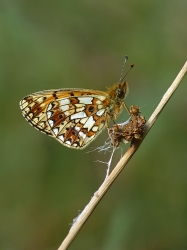 |  |
| New Forest Pearl Photo © Neil Hulme | SPBF male Photo © Neil Hulme | SPBF female Photo © Neil Hulme |
Spring butterflies at Yew Hill. Good variety of butterflies in overcast conditions at Yew Hill today, including Dingy Skipper (5), Grizzled Skipper, Green Hairstreak, Common Blue (3), Small White, Brown Argus and Small Heath (3).
Also lots of Starlings, Common Whitethroat, Greater Butterfly Orchid and, most encouragingly, some good patches of Horseshoe Vetch in flower; hopefully this will help arrest the decline of the Chalkhill Blue at the reserve. [Posted by Rupert Broadway]
Paulsgrove Chalk Pits. Today I visited Paulsgrove Chalk Pits (SU6306). The weather was cloudy with the temperature 15 degrees. Here I found several colonies of Small Blues, all fresh and in good numbers. Several Common Blues were also flying as well as the first female I have noted this year. A single Painted Lady rested for some time on bare chalk.
Totals: Common Blue 8M 1F, Small Blue 25, Small Heath 1, Painted Lady 1. [Posted by Roy Symonds]
A 'Blue Beauty'. Despite the rather indifferent weather forecast for today, I thought I would motor up to Old Winchester Hill in the hope for a break in the rather gloomy conditions. I trudged along to the South side of the Fort to investigate the ditch for a brave insect or two. Several small white moths along with 6 Small Heath .... suddenly a blue flash caught my eye; a glorious Adonis Blue - what a butterfly. It certainly made my trip worthwhile. During my return to the parking area, a Painted Lady flew rapidly across the path in front of me - despite the conditions, a good three or so hours well spent. [Posted by Geoff Jones]
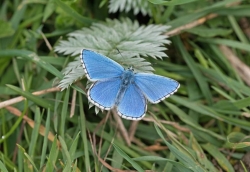 | 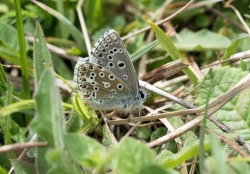 |
| Photo © Geoff Jones | Photo © Geoff Jones |
Marsh Fritillary emergence. As promised, here is my latest update regarding our on-going Marsh Fritillary captive breeding programme (under licence), as part of a major project aimed at re-introducing the Marsh Fritillary to its former stronghold in north-east Hampshire. This is a partnership project between Butterfly Conservation and the Hampshire and Isle of Wight Wildlife Trust.
We were anticipating the first butterflies to emerge from the pupae in the first week of May, but the pupal stage lasted longer than expected, and we were getting a bit anxious. However, I am very pleased to announce that over the last few days, all of our captive breeders have reported the emergence of their first Marsh Fritillaries. These are males, but hopefully females will soon follow, and then we wait with great anticipation for the first egg batches. The attached photos were taken this morning. I should have added that the large cages are full of Devil's-bit Scabious and nectar sources. [Posted by Andy Barker]
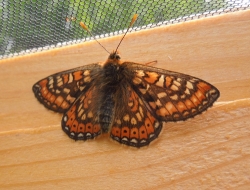 | 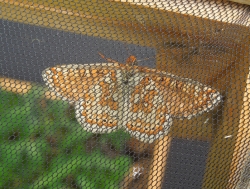 |
| Freshly emerged Marsh Fritillary Photo © Andy Barker | Underside Marsh Fritillary Photo © Andy Barker |
Commas and Small Tortoiseshell releases. As mentioned earlier, I have reared some Commas and Small Tortoiseshells to release and help boost numbers in my Chandlers Ford garden. Today we released 5 Commas and a further 2 Small Tortoiseshells. (6 were released at the weekend) The weather could have been better but it was quite warm and still. Funny how the first thing they do is fly over the hedge to go nextdoor! Having said that a couple did stay long enough to check out the wild flowers and let me snap a few pictures.
I still have 4-5 Commas and a Tortoiseshell left to hatch out so will hopefully release these by the weekend.
As I write this at 18.45pm, David has just come in from the rain to say he has seen a Speckled Wood heading for cover in the ivy on our Oak tree!...and the Comma in the photograph below is still sat on the Foxglove sheltering under the large leaves. [Posted by Tracy Piper]
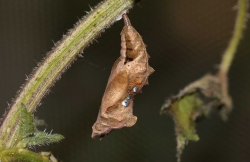 |  | 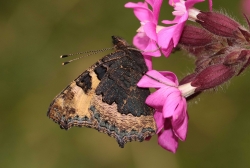 |
| Comma pupa Photo © Tracy Piper | Comma resting on a Foxglove Photo © Tracy Piper | Small Tortoiseshell on Red Campion Photo © Tracy Piper |
Busy Martin Down.. A visit to Martin Down today from 09.30-13.30 produced a wealth of species including six mating pairs (2x Small Blues/Marsh Fritillaries/Small Heath/Grizzled Skippers/Common Blues). The species counts were Small Blue 20+, Common Blue 10, Holly Blue 1, Brown Argus 4, Grizzled Skipper 24, Dingy Skipper 12, Marsh Fritillary 14, Brimstone 8, Peacock 1, Small Heath 30+, Small Copper 2, Green Hairstreak 6, and a superb White Ermine moth. [Posted by Mark Pike]
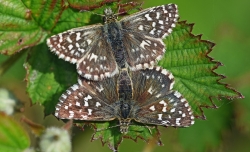 | 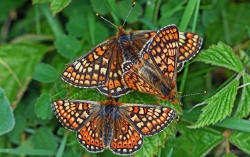 |  |
| Grizzled Skippers Photo © Mark Pike | Marsh Fritillaries & Observer! Photo © Mark Pike | Small Blues Photo © Mark Pike |
Old Winchester Hill NNR. A look at Old Winchester Hill today after the deluge over the last couple of days. Other than the grasses being very wet it was still very dry underfoot. I specifically went there to see if the Duke of Burgundy was still clinging on, after such weather and the slope which has been significantly 'scrub bashed' and with grazing around the clock the Duke is just about hanging on. Areas of Cowslip have been significantly reduced, although the weather may be playing a part in this with stunted growth. I managed to see (4) three of these were in very rude health, this site is quite late and they had obviously only been out a few days. Other species being seen on the site which looks almost as if its been mowed by a lawnmower, were as follows: Small Heath (4), Dingy Skipper (17) Common Blue (15) Speckled Wood (1) Green-veined White (1) Red Admiral (3) Grizzled Skipper (3). It was sadly lacking four species today Adonis Blue, Brown Argus, Green Hairstreak and Small Copper. [Posted by Ashley Whitlock]
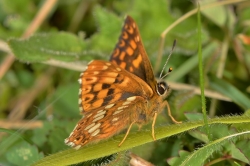 | 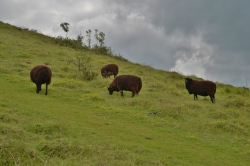 | 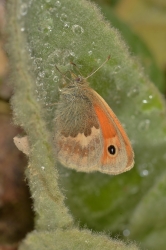 |
| Dukes still in fine fettle Photo © Ashley Whitlock | Grazing on the Northern slope Photo © Ashley Whitlock | Small Heath drinking rain drops Photo © Ashley Whitlock |
Portsdown Hill Small Blues. Walked the path immediately in front of Fort Widley (SU657063) overlooking Queen Alexandra Hospital. With breezy conditions not much was flying but my disappointment was compensated by the sighting of 2 fresh Small Blues. Totals: Common Blue 6M and Small Blue 2. [Posted by Roy Symonds]
Chalton Down, Old Idsworth. Visited Chalton Down (SU736156) today. There was a strong breeze and despite that fact there was overcast spells the temperature was 19 degrees. The breezy conditions were not ideal for the Skippers as I saw none. Totals: Brimstone 2M 1F, Large White 1, Small White 1, Common Blue 2M, Small Heath 2. [Posted by Roy Symonds]
Small Copper at Martin Down. Whilst enjoying a superb range of butterflies at Martin Down on Sunday, my son Frank noticed a strange looking butterfly that initially defied identification, fortunately it landed in front of us and proved to be 'just' a Small Copper, but with a partially white forewing. An unexpected and delightful surprise. [Posted by Kevin Haggar]
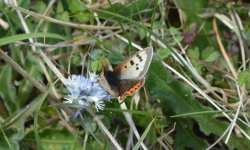 |  |
| Small Copper at Martin Down Photo © Kevin Haggar | Small Copper - 'normal side' Photo © Kevin Haggar |
Small Blue at Pitt Down, Winchester. Very pleased to record a single pristine Small Blue on the Pitt Down transect this afternoon. They disappeared from this site several years ago through overgrazing of the food plant; and although one swallow doesn't make a summmer, we can only hope they have made a return. That apart, single Small Copper and Dingy Skipper were the other species of note. [Posted by Rupert & Sharron Broadway]
 |
| Small Blue at Pitt Down Photo © Rupert & Sharron Broadway |
Stockbridge Down Field Trip. Almost perfect weather greeted us today, with a strong breeze probably keeping counts lower than what they should be. However as we started off just inside of the car-park we were greeted by our first Duke of Burgundy and Pearl-bordered Fritillary. I think the National Trust are doing a fine job of coppicing the woodland by the side of the road , and here where there is lots of areas now for Primroses and Dog-Violets to mature , I think this will be a splendid area to see these two species in future years. We were hunting for the elusive Green Hairstreak but it really did elude us , as we only managed to espy it in the tree tops. Other areas where there has been coppicing it's now grown very scrubby and here there were several other Pearl-bordered Fritillaries. One obviously a female as she was egg laying swiftly as she flitted between feeding. We managed to see up to five Duke of Burgundies (4) which were in the old Woolbury Fortification. I had never encountered them here before which was a huge plus. Other butterflies on the wing were Brimstone (40) Small Heath (8) Holly Blue (2) Grizzled Skipper (5) Small Copper (3) Dingy Skipper (5) Orange-tip (4) Common Blue (8) Green Hairstreak (3),Peacock (1) Red Admiral (1) Green-veined White (1).I know a lot of observers went away happy and that's what it's all about! [Posted by Ashley Whitlock]
Yew Hill, Winchester visit. Decided on the spur of the moment to visit Yew Hill for a look ‘round. We got there about 11am and stayed for two hours. The weather was very warm, when the sun was shining and, unlike the visit we made on the 25th April, when we saw no butterflies, today proved to be far more rewarding.
First butterfly we saw was a Small Heath as we made our way up to the reserve. Along the hedge row was a female Holly Blue and a male Orange-tip that flew past. The usual Brimstones were also present. As we got into the reserve, the first butterfly we saw was a Dingy Skipper! It soon paired up with another and they spiralled around each other for a minute or so. There were several along the top path and more as we made our way to the bottom slope of the reserve. There were more Common Blues, Small Heaths and more Brimstones here and a female was laying eggs on the Buckthorn. We were here last year on the 20th May and saw only a handful of Dingy Skippers and there were definitely more here today. I would say, about 10 – 15. Unlike last year however, we saw no Grizzled Skippers or Brown Argus which is a pity. On the way back along the top of the slope we spied a Green Hairstreak nectaring on Speedwell.
There was a Mother Shipton moth that led us a merry dance because it was quite orangey in colour and we thought it was a strange butterfly! Fortunately Dave managed to get a fuzzy shot of it but it was enough to identify it by when we got home.
Final counts were, Orange-tip 1 male, Common Blue 4 male , Holly Blue 2 female , Small Heath 6-8, Dingy Skipper 10 – 15, Green Hairstreak 1 male , Brimstone 3 male , 4-6 female.
I am hand rearing some Small Tortoiseshells and Comma butterflies to help boost numbers in our Chandlers Ford garden. Yesterday I released 3 Small Tortoiseshells that had emerged and when we got back from Yew Hill, I released 3 more. Looking forward to seeing the Commas as I have not reared these before. I will post some pics and numbers when these start to hatch. [Posted by Tracy Piper]
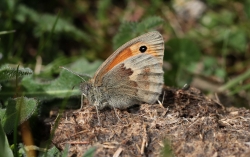 | 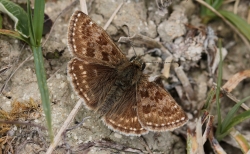 | 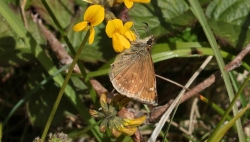 |
| Small Heath Photo © Tracy Piper | Dingy Skipper Photo © Tracy Piper | Dingy Skipper underside Photo © Tracy Piper |
Yew Hill visit cont..... ....more photos [Posted by Tracy Piper]
 | 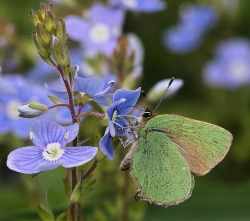 |  |
| Common Blue Photo © Tracy Piper | Green Hairstreak on Speedwell Photo © Tracy Piper | Holly Blue female Photo © Tracy Piper |
More From Martin Down. Some photographs of the supporting cast http://awayfromfourmarks.blogspot.co.uk/ [Posted by Chris Rose]
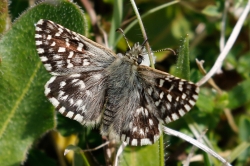 | 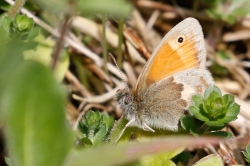 | 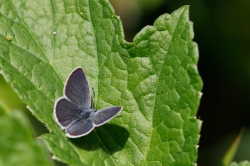 |
| Grizzled Skipper Photo © Chris Rose | Small Heath Photo © Chris Rose | Small Blue Photo © Chris Rose |
Sunny Afternoon on Martin Down. I timed the day just right arriving at Martin Down as the afternoon warmed up. Walking west along the side of the hedge my first butterfly was a Small Blue, a good sign. I then walked south east along the Bokerley Ditch and the Marsh Fritillary appeared. Only including those I found ahead of me I counted 28 individuals, with one pair observed mating. The supporting cast was provided by 12 Dingy Skippers, 8 Grizzled Skippers 5 Common Blues, 6 Small Blues, 3 Small Heath, 2 Orange-tip, and 12 Brimstones. http://awayfromfourmarks.blogspot.co.uk\ [Posted by Chris Rose]
 | 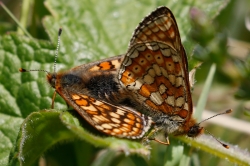 | 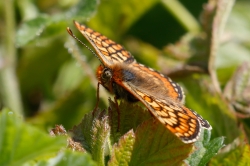 |
| Marsh Fritillary Photo © Chris Rose | Marsh Fritillary Pair mating Photo © Chris Rose | Marsh Fritillary Photo © Chris Rose |
Martin Down At Its Springtime Peak. I visited Martin Down this afternoon in breezy conditions, walking the paths close to the Bokerley Ditch for about a mile, starting from the rifle range. Fresh Marsh Fritillaries and Adonis Blues were the highlights, but most of the spring species are still on the wing. Counts were as follows - Marsh Fritillary (14), Adonis Blue (7), Small Blue (16), Brown Argus (7), Common Blue (6), Dingy Skipper (6), Small Heath (3), Green Hairstreak (3)(in Hawthorn near the ditch), Brimstone (9), Peacock (2). Another observer indicated that a freshly emerged female Duke Of Burgundy had been seen in the ditch earlier in the week, which suggests they may also be breeding there. [Posted by Alan Thornbury]
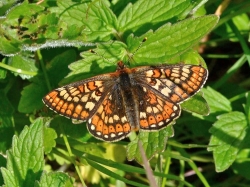 | 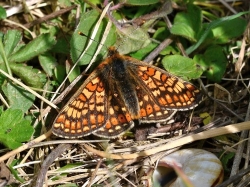 |  |
| Marsh Fritillary Photo © Alan Thornbury | Marsh Fritillary Photo © Alan Thornbury | Adonis Blue Photo © Alan Thornbury |
Martin Down. Paid a fleeting visit to Martin Down today. The weather on the way there was dire but thankfully picked up as we made our way over to the Bokerley Ditch. As the sun broke through there were lots of Dingy Skippers, less so Grizzled Skippers. 4 Green Hairstreak and another 4 of Common Blue. Lots of Brimstone in the Ditch - probably as many as I have ever seen at a single site. Star of the show though was undoubtedly Marsh Fritillary (5) - is there a more striking butterfly? The only negative was a non butterfly one - I didn't see or hear a turtle dove - hopefully it was just the morning weather that put them off or perhaps they are too busy nest building! [Posted by Mark Wagstaff]
 | 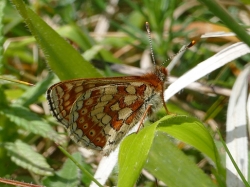 | 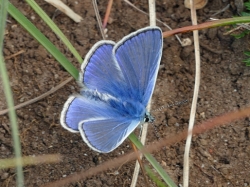 |
| Marsh Fritillary Martin Down Photo © Mark Wagstaff | Marsh Fritillary Martin Down Photo © Mark Wagstaff | Common Blue Martin Down Photo © Mark Wagstaff |
Small Down, East Meon Field Trip. Another weekend and another field Trip, and of course starting off under very heavy leaden skies, it didn't look good as we got up onto the downs we were hit by a very heavy squally shower, which didn't bode well. We finally made on to the site after about 20 minutes of walking. We didn't see anything for the first 45 minutes, and like most weekends it started to get warmer, and the sun started piercing the grey clouds. The first butterfly seen was a Common Blue, then a Small Heath, followed by a Dingy Skipper coming into view, soon the skies really cleared and it was like a summer's day, but it was very windy which kept a lot of the counts lower than usual. I've been to this site now several times, and where there has been scrub bashing and cattle grazing there certainly seems more Cowslips. This is one of the best potential sites I've seen where the Duke has yet to move in, but when it does I think it will be very happy here, being only 1 mile from the best Duke site in Hampshire. Counts eventually were as follows, Common Blue (25) Small Heath (3) Holly Blue (2) Dingy Skipper (15) Grizzled Skipper (5) Green-veined White (1) Brimstone (3) Red Admiral (1). I'd like to thank everyone that came and endured the grotty weather but again perseverance was the watch word. [Posted by Ashley Whitlock]
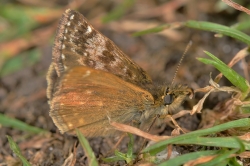 | 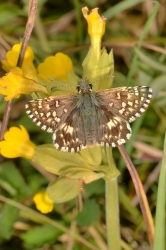 | 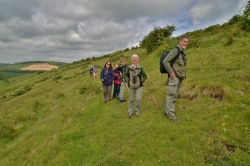 |
| Dingy Skipper female Photo © Ashley Whitlock | Grizzled Skipper and Cowslip Photo © Ashley Whitlock | Navigating around Small Down Photo © Ashley Whitlock |
Noar Hill. After visiting Chalton Down, later in the afternoon, my wife and father visited Noar Hill (SU7431). The weather was overcast with the grass still wet from the morning showers. As I was returning to Cornwall the following day, I was determined to find a Duke of Burgundy. Despite much searching in areas where I usually find it and with the sun not appearing long enough, I was about to give up. Not a single butterfly was seen until the sun came out for a 10 minute period which warmed things up. In the clearing just past the Triangle suddenly I spotted a single male Duke of Burgundy. After a few photos he retired to rest on the outer branches of a bush. Only one sighting but one happy lepidopterist! [Posted by Richard Symonds]
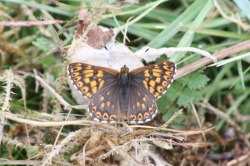 | 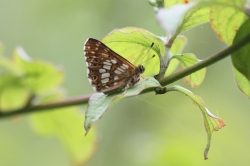 |
| Duke of Burgundy Photo © Richard Symonds | Duke of Burgundy at rest Photo © Richard Symonds |
Chalton Down, Old Idsworth. On 12th May on a visit from Cornwall due to a family bereavement, my wife and I accompanied my father on a visit to my old haunts Chalton Down (SU736156). The weather was cloudy with a few sunny spells, until before we left just over an hour later when a light shower arrived. Some minor scrub clearing had taken place. Several Dingy and Grizzled Skippers - my target species were seen in quite good numbers, including a mating pair of Dingy Skippers. Numbers of other species were much lower due to the weather, but still a worthwhile visit.
Totals: Brimstone 1M, Green-veined White 1, Common Blue 2M, Small Heath 6, Peacock 1, Dingy Skipper 16, Grizzled Skipper 5. [Posted by Richard Symonds]
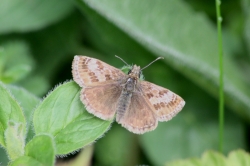 |  | 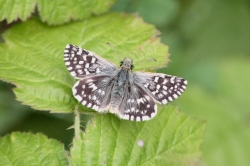 |
| Dingy Skipper Photo © Richard Symonds | Dingy Skipper at rest Photo © Richard Symonds | Grizzled Skipper Photo © Richard Symonds |
Havant Thicket, Brimstones Galore. Visited Havant Thicket in sunshine, the temperature was 14 degrees. Brimstones of both sexes were flying in very good numbers and were seen almost everywhere. I walked the entire outer track of the woods, where Whites and other Spring species were seen.
Totals: Brimstone 19M 14F, Orange-tip 1M 1F, Green-veined White 2, Small White 7, Speckled Wood 2, Peacock 1, Red Admiral 1. [Posted by Roy Symonds]
Small Blue at Noar Hill. Having spent a few short hours yesterday re-acquainting myself with the small numbers of Duke of Burgundy along with Orange-tip, Green Hairstreak, numerous Dingy Skippers, Holly Blues etc., upon negotiating the well worn paths towards the less steep exit gate, I spotted a Small Blue, sadly way beyond the reach of my 105mm macro lens. Attempting to climb the high bank on which the butterfly briefly landed would have caused damage to the various plants clearly struggling to survive our recent dry weather. I called to two fellow visitors who were walking along the top of the bank that the Blue had flitted towards them. The gentleman later confirmed that the Small Blue has, at various times been reported at Noar Hill, a fact I was unaware of. [Posted by Geoff Jones]
Marsh Fritillary at Martin Down. Visited Martin Down today and the Marsh Fritillaries are flying. There were approx. 15 in Bockerley Ditch east of Point B on Walk 19, and approx 5 near Point C of Walk 19 [Posted by Bryn Jones]
Bentley Wood & Magdalen Down. I visited Bentley Wood and Magdalen Hill Down today - an odd combination perhaps but the weather looked good for today so I hoped to make the most of it. At Bentley Wood there were plenty of fresh Pearl-bordered Fritillaries in evidence - I only stayed 30 mins as I wanted to get to Barnridge Copse but managed double figures in that short spell - and evenly distributed over the Eastern Clearing. No Marsh Fritillaries at Barnsridge Copse - I was probably a week (or even two) early and I'm not sure this small colony is still even viable but it's a lovely walk to get to it and I was at least rewarded with lots more PB fritillaries (20+). The contrast since last year underfoot was remarkable - last year was wellies in the copse and even they were 'challenged' in getting there - this year sandals would have sufficed. It is tinder dry.
On then to Magdalen Down - just perfect for Brown Argus which were out in force - 20+ just along the bottom path of the old reserve. Also managed a single Small Blue in the chalk pit and an unexpected Dingy Skipper. A couple of Green Hairstreaks also on the hill and 6 Common Blues. Wonderful day. [Posted by Mark Wagstaff]
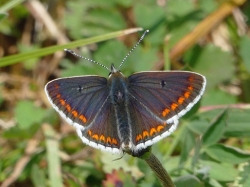 | 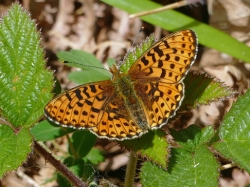 |  |
| Brown Argus Magdalen Down Photo © Mark Wagstaff | Pearl Bordered Fritillary - Eastern Clearing Photo © Mark Wagstaff | Brown Argus Magdalen Hill Down Photo © Mark Wagstaff |
Marsh Fritillary at Magdalen Hill Down. After a pleasant morning strolling around MHD snapping away at Brown Argus (20+) and Green Hairstreaks (10+), I was somewhat surprised to come across a Marsh Fritillary on the lower slope of the extension field by the A31. It was a singleton,didn't stay long and disappeared up the slope but I was able to grab a few hasty shots so that I didn't disbelieve it myself! [Posted by Phil Hooper]
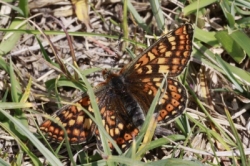 | 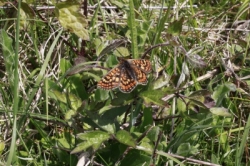 |
| Photo © Phil Hooper | Photo © Phil Hooper |
Butser Hill (Rake Bottom). This valley is full of butterflies at the moment. You don't have to search for them - they are all around you. My numbers below are undoubtedly under recorded, because I was preoccupied with attempting to video them.
Peacock (1), Small Heath (5), Common Blue (4), Green Hairstreak (3), Duke of Burgundy (25), Dingy Skipper (18), Grizzled Skipper (5), Brimstone (3), Orange-tip (2) [Posted by Michael Berry]
Oxenbourne Down/ Wascoombe Bottom, Butser Hill. According to the forecast today it was going to be overcast, so I decided to go to my local Duke patch and it was anything like the weather forecast, a bit cool but lovely sunshine. There were plenty of Dingy Skippers on the wing, but the Duke count was low, whether this was the cold nights of late, or a cool breeze blowing across the downs kept the numbers, down. However I did see a female in Wascoombe Bottom which was a surprise, however this female will probably never be mated any male finding her would have to be extra-ordinarily lucky. I also saw a Badger which almost brushed past me, this has to be quite odd behaviour as the weather has been so dry they are obviously out searching for food longer. Counts were as follows :Dingy Skipper (30) Small Heath (10) Red Admiral (5) Green Hairstreak (1) Common Blue (3) Grizzled Skipper (4) Duke of Burgundy (6) Peacock (2) Brimstone (7) Speckled Wood (1) Orange-tip (4) Small White (1) and last but not least Green-veined White (1) [Posted by Ashley Whitlock]
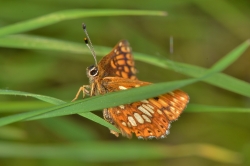 | 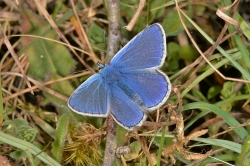 | 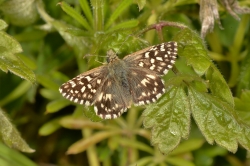 |
| An unlucky lady............ Photo © Ashley Whitlock | Common Blue Photo © Ashley Whitlock | Grizzled Skipper Photo © Ashley Whitlock |
Havant Thicket. This was meant to be a Nordic Walk, but we kept stopping to enjoy the butterflies: Peacock (1), Small Heath (swarm of 20), Speckled Wood (2), Holly Blue (1), Small Copper (2), Dingy Skipper (1), Grizzled Skipper (1), Brimstone (1), Green-veined White (1), Orange-tip (2).
Our physical workout may have been impaired, but the butterflies lifted our spirits. [Posted by Michael Berry]
West Butser Hill. After getting back to the Butser Hill car-park some decided they were going home but I did suggest whilst the sun was shining to make good use of it and visit one of my favourite bits of Butser Hill, which we duly did and wandered over to west Butser Hill. It was really warm now and the butterfly count was really good, with the Duke of Burgundy (17) Grizzled Skipper (10) Brimstone (4) Green-veined White (2) Green Hairstreak (1) Dingy Skipper (5)Peacock (2) Speckled Wood(1) Orange-tip (1) Small Heath (1). I had people from Suffolk and Essex today and that's an awful long way to come in such cold overcast conditions and hoping to see something which they duly did and I would like to thank them, and my usual butterfly walkers, for being patient and getting just rewards in the end! [Posted by Ashley Whitlock]
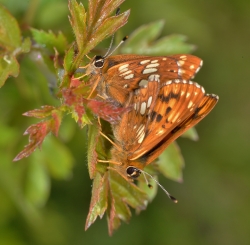 | 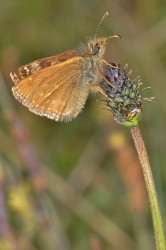 |  |
| Saw these two starting to mate, no standing on ceremony here! Photo © Ashley Whitlock | Dingy Skipper Photo © Ashley Whitlock | Green Hairstreak Photo © Ashley Whitlock |
Ramsdean Down Field Trip. This looked on paper that it was going to be cold overcast windy and totally butterfly less, which it was for the first hour. We heard the Cuckoo perhaps most of the field trip, which kept our spirits up. We got round to Ramsdean Down at Grandfathers Bottom, and I suggested we have our lunch about 12:00 with a glimpse of blue skies on the horizon. We had managed to kick up or notice one cold female Duke of Burgundy and a Small Heath by this time but that was all. However the sun came out and so did the butterfly count, and we quickly retraced our steps back to the bottom of Butser Hill. Here the tally was as follows: Between Ramsdean and the bottom of Butser Hill, Duke of Burgundy (40+)Small Heath (6) Common Blue (3) Grizzled Skipper (6) Dingy Skipper (9) Orange-tip (1) Cinnabar Moth (2) Yellow Shell (3) Red Admiral (3). [Posted by Ashley Whitlock]
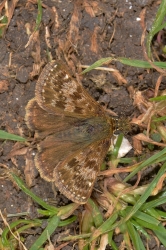 | 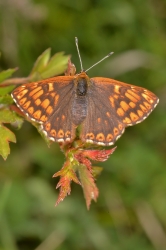 | 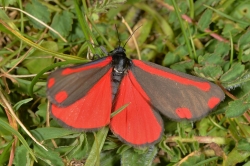 |
| Excellent camouflage Dingy Skipper Photo © Ashley Whitlock | Duchess of Burgundy Photo © Ashley Whitlock | Cinnabar Moth Photo © Ashley Whitlock |
Keyhaven. An afternoon walk around the sea wall at Keyhaven in the sunshine provided some wonderful views of at least 8 Small Copper and a very confiding Green Hairstreak. Unfortunately there was no sign of any Wall Browns. Two of the Small Coppers were showing the blue spots on the hind wing of the aberrant form caeruleopunctata. Many thanks to Pete who pointed out this form [Posted by Chris Rose]
 | 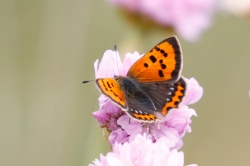 | 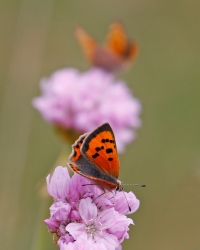 |
| Green Hairstreak Photo © Chris Rose | Small Copper - caeruleopunctata Photo © Chris Rose | Small Copper Photo © Chris Rose |
Chalton Down, Old Idsworth (SU736156).. Today in sunshine and the temperature reaching 17 degrees, I paid a visit to Chalton Down (SU736156). Here several male Brimstones were flying as well as Holly Blues along the hedgerows and scrub. Up on the higher slopes I saw a single Grizzled Skipper which posed for several photos along with a few fresh Dingy Skippers. A total of 8 different species were seen including my first Small Heath this year.
Totals: Brimstone 7M, Orange-tip 1M, Small White 2, Holly Blue 5, Small Heath 2, Peacock 1, Dingy Skipper 5, Grizzled Skipper 1. [Posted by Roy Symonds]
Small Blue Take Wing At Magdalen. I spent an hour on Magdalen Hill Down this morning as the warmth of the sun began to get the better of the chilly easterly breeze. The primary target species was Small Blue and indeed they are on the wing there.
I only saw a singleton at the chalk pit, but two more Small Blues were flitting amongst the Garlic Mustard in the SW corner of the extension, which was probably the most productive area for butterflies. It is of course a magnet for Orange-tips (12 seen), including courting couples, but other species of note here included Green Hairstreak (3), Dingy Skipper (1) and Holly Blue (2). Two fresh Brown Argus were also seen on the lower slopes of the original reserve and two more Dingy Skippers to complete a short but enjoyable walk. [Posted by Alan Thornbury]
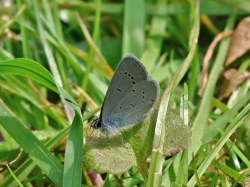 |  | 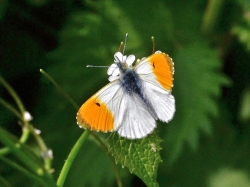 |
| Small Blue Photo © Alan Thornbury | Green Hairstreak Photo © Alan Thornbury | Orange Tip Photo © Alan Thornbury |
Westbury Park, between East Meon and West Meon. It was a surprise today to get out after such a dreary week with thick cloud hanging over most of the Duke sites in the Meon Valley. However today it was very breezy, but in sheltered areas when the sun was out which was most of the time it was very warm indeed. One Duke site had upwards of fifteen individuals on the wing but I do think the wind probably hampered a better count and many were still sheltering, however its still only the 6th May. I visited Westbury Park again and this time the Dukes were well out on the wing with one of the best counts I've ever had at this site, with several individuals being seen well away from the main arena. A lovely pair were seen mating, and (11) individuals were seen in all. Other species seen were Red Admiral (4) Peacock (9) Speckled Wood (2) Green-veined White (2) Holly Blue (8) very common flying in amongst the Hawthorn bushes. Brimstone (5) Dingy Skipper (4) Small White (3) Orange-tip (1). However this site is under threat it has been put up for sale now the Hospital is to become housing, and the rest of the park is probably going to be developed. So how much longer the Duke can cling on here is anybody's guess. [Posted by Ashley Whitlock]
Trip to MHD. Spent a very enjoyable four hours at Magdalen Hill Down today between 10 and 2. We started at the lower part of the reserve behind Blackwell and Moody’s, looking for Green Hairstreaks, and were not disappointed. There were a fair number in the bottom furthest corner. It was good to see 2-3 sitting on the bushes at any one time. They were dancing around each other and defending territories against each other and the odd Brimstone, Holly Blue and Orange-tip that strayed too close. I love these beautiful little butterflies, showing every shade of green you can imagine in their shimmering wings. We spent an hour watching them and photographing them before moving through the chalk pit and on to the old part of the reserve. Here, we saw several more Brimstones, both male and female and a lot of egg laying going on. Dave spotted a Grizzled Skipper but it wasn’t in the mood for having its photograph taken. There were a couple more Green Hairstreaks here and a very early lone Small Heath. Dave saw a single Peacock and later a couple of Small Tortoiseshells chasing each other. We walked right to the end gate but saw no more Skippers. There was the odd Holly Blue though. We then proceeded back towards the bottom of the extension slope and visited the large patch of Garlic Mustard there. More photographic opportunities with male Orange-tips and Green-veined Whites here. We saw no female Orange-tips but one of two female Green-veined Whites. Dave wandered along the bottom path here and spotted a Dingy Skipper which he managed a rushed snap of. We carried on along the bottom path and up the other side but saw no butterflies other than more Orange-tips and Brimstones along here. All in all a pleasant day, getting some good shots of Orange-tips, Green Hairstreaks and Green-veined Whites. The weather was on the whole good and warm but with quite a lot of cloud which built up as the day went on.
I’m not a great counter, because I concentrate more on the studying and photography side but here goes…. All together we saw
10 -15 Green Hairstreaks, 5-8 Holly Blues, 15+ Brimstones, 6-10 Orange-tips (all male) 5-7 Green-veined Whites, 1 Small Heath, 1 Peacock, 2 Small Tortoiseshells, 1-2 Grizzled Skippers, 1 Dingy Skipper. [Posted by Tracy Piper]
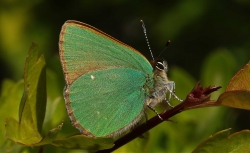 | 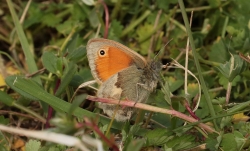 | 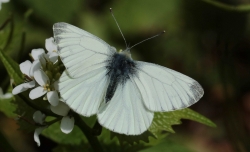 |
| Green Hairstreak male Photo © Tracy Piper | Early Small Heath Photo © Tracy Piper | Male Green-veined White Photo © Tracy Piper |
Trip to MHD cont..... ..... more photos [Posted by Tracy Piper]
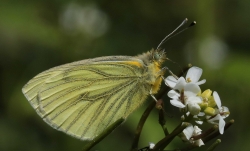 | 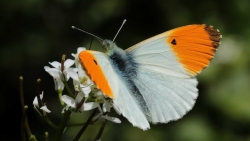 | 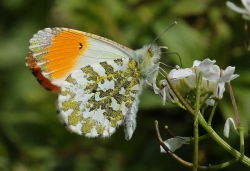 |
| Green-veined White male Photo © Tracy Piper | Orange Tip male Photo © Tracy Piper | Orange Tip underside Photo © Tracy Piper |
Pearl Count In Bentley Somewhat Below Par. A couple of lunchtime circuits of the Eastern Clearing in Bentley Wood and a foray into the cleared area just to the north, produced a somewhat meagre count of just 5 Pearl-bordered Fritillaries, despite good sunny spells. Most of the fritillaries seemed to be just passing through, since there were periods when I suspect none was actually present. It is perhaps not a coincidence that the disappointing count is at least partly linked to the rapid growth and expansion of shrubs in the clearing, such as hazel. I noted from the visitor book that the first Pearl-bordered Fritillary in the clearing was recorded way back on the 23 April and not all the specimens I saw were fresh. [Posted by Alan Thornbury]
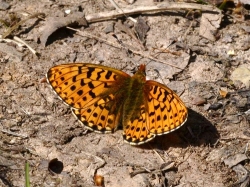 | 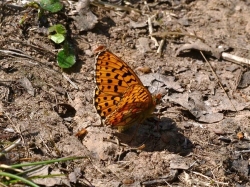 |
| Pearl-bordered Fritillary Photo © Alan Thornbury | Pearl-bordered Fritillary Photo © Alan Thornbury |
Noar Hill. Visited Noar Hill this morning - effectively my first butterfly trip of the year that required travel. Noar Hill never seems to disappoint - from the yellowhammer singing at the entrance to an unexpected Holly Blue in deep cloud cover at the end. Duke of Burgundy just reached double figures - a couple showing their age but most in tip top condition. Also 4 Orange-tip, 6 Dingy Skipper and my first Small Heath of the year - all in less than 2 hours. To the enthusiast I met there - it was a pleasure to meet up and fingers crossed you found a Green Hairstreak after I left! Wonderful first trip out - fritillaries next! [Posted by MarK Wagstaff]
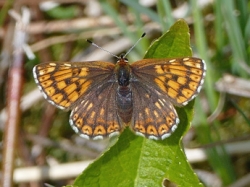 | 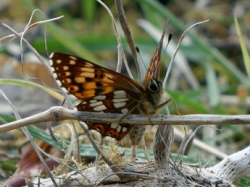 | 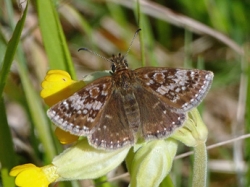 |
| Duke of Burgundy Noar Hill Photo © MarK Wagstaff | Duke of Burgundy - Alternative View! Photo © MarK Wagstaff | Dingy Skipper Noar Hill Photo © MarK Wagstaff |
Oxenbourne Down. A dry and bright day and once again trekking over some familiar ground this time being far more successful than last week. The weather wasn't particularly warm as I arrived on site however at 0930 in the morning the Dingy and Grizzled Skippers were out and doing battle, several Dingy Skippers were having a real battle, then settling down on their perches mainly on Ground Ivy. I was optimistic about the Duke, and when I stumbled across one in a 'new' area I was very pleased. This area was where the once clear felled area of Coniferous trees were, and now there is good amounts of scrub. I then encountered another in an area I've never seen one before quite close to the main arena, so it may well have been a wanderer. I don't think we give this little butterfly enough credit for its meanderings and wanderings to find suitable habitat. In the main arena I counted upwards of (10). But the Gorse certainly needs a lot of attention, and I did note it in the area of the main slope, so it could easily utilize this area if it became too intolerable on the main downland. Other species of note were as follows: Dingy Skipper (15), Grizzled Skipper (6) Small Heath (5) Brimstone (22) Peacock (4) Small White (1) Large White (1) Orange-tip (2) Green-veined White (1) Red Admiral (1) and last but not least Holly Blue (1) and a lovely Yellow Shell Moth. [Posted by Ashley Whitlock]
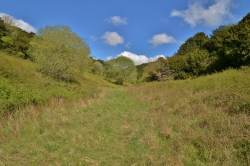 | 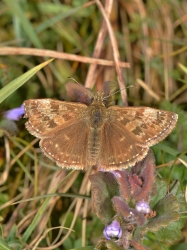 | 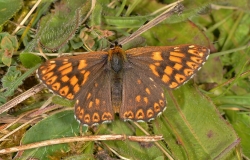 |
| Wascoombe Bottom Oxenbourne Down Photo © Ashley Whitlock | Dingy Skipper and Ground Ivy Photo © Ashley Whitlock | Male Duke of Burgundy Photo © Ashley Whitlock |